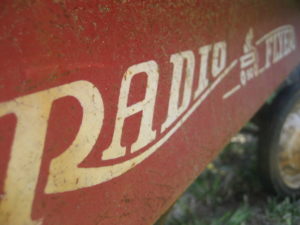There’s a reason a toy becomes a classic. Either it’s extremely well-designed and durable, or it captures the child’s imagination in a unique way that stands the test of time. The holiday season is nearing, and you may want to grab some of that retro magic as you shop for presents. Here are five classics toys to consider and some inside information on what made them great.
Radio Flyer Wagons
These iconic red wagons take children outdoors to play, something that many of today’s toys do not accomplish. The American Toy Company, founded in 1917 by Antonio Pasin designed them. For the first ten years, the wagons produced were wooden, but in 1927 Pasin took advantage of modern manufacturing techniques and began to produce steel-bodied wagons on an assembly line. The name, Radio Flyer, was chosen in honor of two contemporary heroes, Guglielmo Marconi, inventor of the first long-distance wireless telegraph and Charles Lindbergh, first pilot to fly solo, non-stop across the Atlantic.
Radio Flyer wagons, tricycles, scooters and bicycles are still readily available on today’s toy market and are still considered sturdy, desirable outdoor toys for both boys and girls.
Erector Sets
The original building toy, the Erector Set, was designed by A.C. Gilbert in Westville, Connecticut. Alfred Gilbert was a magician and his first toys were sold as supplies for magic tricks. He invented the concept of the erector set in 1911, basing the pieces on railroad girders. He first produced the boxed set in 1913. In 1929 Gilbert purchased the British Meccano toy company and continued toy production under that name. The Meccano company also produced scale model trains, microscopes and chemistry sets. Erector sets are still available from Meccano. Building toys build small muscle coordination and encourage problem solving and focus on a practical outcome.
Play Doh
Who can imagine a world without play doh? The original product was created of flour, water, salt, boric acid and mineral oil in the 1930’s and was intended as a wallpaper cleaner. When a classroom of children used to product as a modeling compound in 1955, the inventors, Bill Rhodenbaugh and Joe McVicker, quickly repurposed the product. It was shown at an educational convention in 1956 and marketed to Cincinnati schools as an art supply. Play Doh is now a staple product in the creative play of preschoolers everywhere.
Mr. Potato Head
This whimsical character was invented by George Lerner in 1949. The original toy was made up of features on push pins meant to be used with real fruit and vegetables and called “Funny Face Man.” It sold for 98 cents. Parents soon complained of the wastefulness of rotting apples and potatoes around their homes and some saw the product as a safety issue. So on May 1, 1952 Mr. Potato Head was born. Created in plastic with the familiar features we know and love, this toy encourages both dexterity and creative, dramatic play.
Viewmaster
Edwin Eugene Mayer, originally a pharmacist at Owl Drug in Portland, Oregon, went into the photo-finishing business in 1919. He learned all aspects of the business of photography. In 1939 he created an updated version of the stereoscope using thin cardboard disks and pairs of color photographs. The original disks were travel views and were meant to be enjoyed by adults and children alike. The final product was introduced at the 1939 World’s Fair and grew in popularity until it became a hit in 1955 when it added reels of Disneyland. The Viewmaster is still created and loved in many versions today. Viewmaster images can be sheer entertainment, or provide lessons in everything from history to geography.




 The Exploits of Edna and Gertie Join the fun, get your copy now!
The Exploits of Edna and Gertie Join the fun, get your copy now!